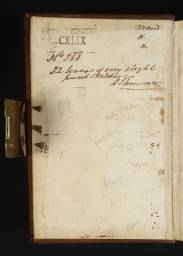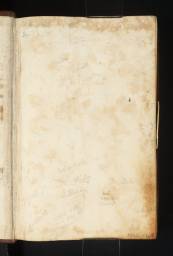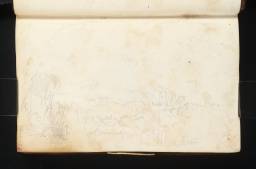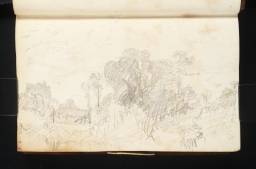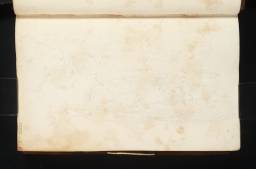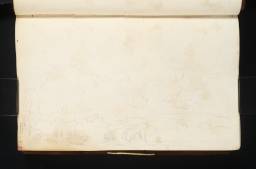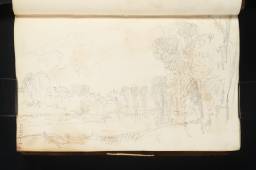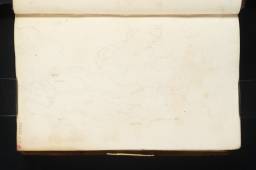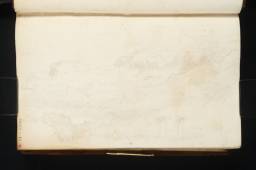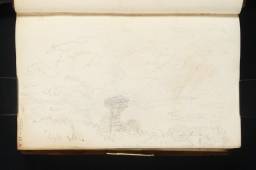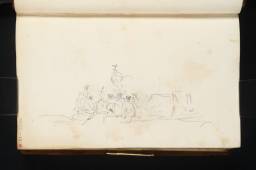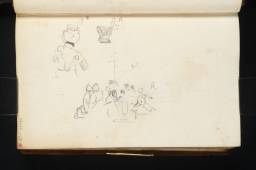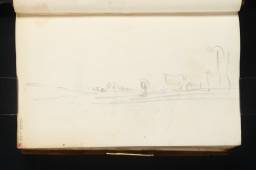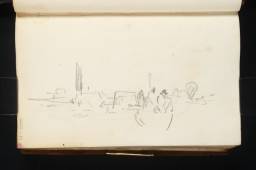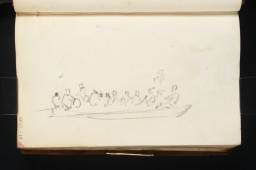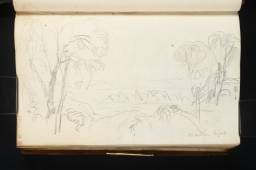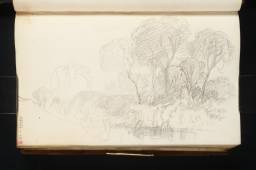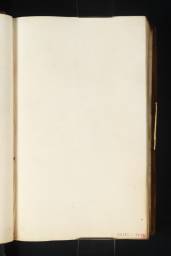Turner Bequest CXLIX
Sketchbook, bound in boards covered in brown suede leather with embossed line and scroll motif round the edges, a brass clasp attached to the outside edge of the front cover and a brass catch plate to the back cover; the spine original and continuous, embossed with five cross bands
302 leaves of white medium-weight wove paper
Approximate page size 149 x 93 mm
Watermarked ‘C ANSELL | 1812’
Turner’s inscription ‘64’ on a label on the spine, noted by Finberg, has disappeared
Endorsed by the Executors of the Turner Bequest in ink ‘No. 368 | 32 leaves of very slight | pencil sketches’ and signed by Henry Scott Trimmer ‘H S Trimmer’ and initialled in pencil by Charles Lock Eastlake ‘C.L.E.’ and John Prescott Knight ‘JPK’
Stamped in ink ‘CXLIX’ top left
302 leaves of white medium-weight wove paper
Approximate page size 149 x 93 mm
Watermarked ‘C ANSELL | 1812’
Turner’s inscription ‘64’ on a label on the spine, noted by Finberg, has disappeared
Endorsed by the Executors of the Turner Bequest in ink ‘No. 368 | 32 leaves of very slight | pencil sketches’ and signed by Henry Scott Trimmer ‘H S Trimmer’ and initialled in pencil by Charles Lock Eastlake ‘C.L.E.’ and John Prescott Knight ‘JPK’
Stamped in ink ‘CXLIX’ top left
Accepted by the nation as part of the Turner Bequest 1856
References
This thick leather-bound notebook belongs to a type that Turner sometimes carried with him on major tours. It contains two series of sketches, beginning separately from each end of the book. One series of twelve records a shooting expedition to the moors at Hall Beck Gill near Farnley Hall, the seat of his Yorkshire patron Walter Fawkes,1 followed by a visit to Sutton Bank in North Yorkshire. Another eighteen cover a river expedition under dramatic skies at an as yet unidentified location which includes a substantial bridge and a castle. It may be that the river expedition is not in Yorkshire. Isolated in the middle of the book are two studies of gun dogs that are probably related to the shooting subjects at Farnley. By far the greatest part of the book – consisting of 270 folios – is unused.
It seems likely that Turner bought the book for intensive use on a tour. Comparable books of the period include the Yorkshire 1 and Yorkshire 2 sketchbooks (Tate D10868–D11041; D40846–D40848; Turner Bequest CXLIV and Tate D11042–D11371; D40844–D40845; D41443; Turner Bequest CXLV), each used in Yorkshire in 1816. Those, however, are considerably less bulky, and it is possible that Turner found the present book less easy to put in and out of his pockets because of its suede surface, and abandoned it as less convenient to use in the field than he had hoped.
The reading of the sketchbook is complicated somewhat by the numbering of the folios. It can be assumed that the brass clasp is attached to the back cover and the catch plate to the front. A right-handed person would normally open the book by holding the spine in the left hand, and sliding the clasp from left to right with the right thumb. Following that logic, Turner’s executors, finding sketches at both ends, appear to have opened the book the wrong way. This is common with regard to the clasped sketchbooks in the Turner Bequest. In his Inventory Finberg took his cue from the executors’ inscriptions, and accordingly the pages are stamped and numbered in their preferred order. Although the numbering is plainly misleading, it would heap confusion upon confusion to attempt here to reverse it. The listing below therefore follows Finberg, but it should be recognised that the Yorkshire moorland subjects were made first at the beginning of the book, and the river and castle subjects on some subsequent occasion when restarting the book from the other end.
The visit to Sutton Bank terminating the Yorkshire moorland sketches prompts consideration of Turner’s itinerary. Sutton Bank is on the western escarpment of the North Yorkshire Moors on the road from Thirsk to Helmsley. The preceding sketches place Turner at Farnley Hall so it seems very likely that he was heading from there to Rievaulx Abbey, which is only a mile or two east of Sutton Bank. Sketches of Hall Beck Gill as found in the present sketchbook, and of Rievaulx occur together in the Devonshire Rivers, No.3, and Wharfedale sketchbook (Tate D09798, D09799, D09804 – Hall Beck Gill; and D09853 – Rievaulx; Turner Bequest CXXXIV 9, 10, 14, 55). The same sketchbook also contains a sketch of Scarborough (Tate D09866; Turner Bequest CXXXIV 65), which would have been a natural continuation of the route eastwards. There are related sketches of Scarborough in the Scarborough 1 and Scarborough 2 sketchbooks (Tate D11914–D11951; D40706–D40707; Turner Bequest CL and D11952–D11973; D40708–D40711; Turner Bequest CLI). All these sketchbooks may relate to the same tour but it should be noted that they were not connected by Turner when he numbered them. The present sketchbook is numbered ‘64’ while the Scarborough 1 and Scarborough 2 sketchbooks are numbered ‘101’ and ‘99’. It should also be observed, however, that Turner’s numbering of clearly-related sketchbooks was sometimes not contiguous as, for example, with the 1816 tour sketchbooks mentioned below.
There is little to date the sketchbook decisively. Finberg suggested 1816–18, the 1980 York exhibition2 offered 1815 and Turner’s biographer Anthony Bailey has more recently opted for 1816.3 The paper is watermarked 1812. There is some general similarity between the sketches of a shoot near Farnley Hall and another in the Large Farnley sketchbook (Tate D09024; Turner Bequest CXXVIII 8, here dated to c.1816) and a finished watercolour of Grouse Shooting (Wallace Collection, London),4 but the connection may be merely circumstantial, since Turner would have joined shoots during any of his numerous visits to Farnley. The sketch-map of places in North Yorkshire inside the front cover and folio 1 recto (D40859, D11596) suggests preparation for a tour, and appears particularly related to that undertaken in 1816 to gather material for illustrations to Thomas Dunham Whitaker’s proposed General History of the County of York. This tour is principally represented by two itineraries, the first recorded in the Yorkshire 2, Yorkshire 4 and Yorkshire 5 sketchbooks (Tate D11042–D11371; D40844–D40845; D41443; Turner Bequest CXLV; Tate D11442–D11479; D11481–D11517; D40839–D40843; D41497; Turner Bequest CXLVII; Tate D11518–D11595; D40860–D40862; Turner Bequest CXLVIII) and the second in the Yorkshire 1 and Yorkshire 3 sketchbooks (Tate D10868–D11041; D40846–D40848; Turner Bequest CXLIV; Tate D11372–D11441; D40835–D40838; Turner Bequest CXLVI).5 On those itineraries Turner visited some, but not all of the sites marked on the sketch maps. Finberg noted of the present volume: ‘This... may not be connected with the Aug.–Sep. 1816 sketching tour, to which the books “Yorkshire 1–5” belong.’ Nevertheless one might surmise that Turner made the maps at least with the Whitaker tour in mind, and the book presumably therefore travelled north with him in 1816.
Circumstantial evidence also tends to a date of 1816. In the Sutton Bank sketches Turner seems to be headed for Rievaulx and Scarborough. Sketches of both subjects appear in the Devonshire Rivers, No.3, and Wharfedale sketchbook (Tate D09853, D09866; Turner Bequest CXXXIV 55, 65). Scarborough is linked via the aforementioned Scarborough 1 and Scarborough 2 sketchbooks to a watercolour of Scarborough (private collection)6 dated 1818. However the Devonshire Rivers, No.3, and Wharfedale sketchbook also contains sketches that are the basis of a watercolour of Leeds (Yale Center for British Art, New Haven, Connecticut)7 dated 1816. Given that there is no reason to suspect that the Yorkshire sketches in the Devonshire Rivers, No.3, and Wharfedale sketchbook are not contemporary with one another and because the studies of Leeds cannot be any later than 1816, it seems that they would by virtue of the probable connection between Rievaulx and Turner’s trend in the present sketches, to point to a date of 1816 for the whole group.
See James Hamilton, ‘Fawkes, Walter Ramsden (1769–1825)’, in Evelyn Joll, Martin Butlin and Luke Herrmann (eds.), The Oxford Companion to J.M.W. Turner, Oxford 2001, pp.103–5.
Andrew Wilton, J.M.W. Turner: His Life and Work, Fribourg 1979 / The Life and Work of J.M.W. Turner, London 1979, no.535
The tour is treated in detail in David Hill, In Turner’s Footsteps: Through the Hills and Dales of Northern England, London 1984, and further material may be found in the same author’s unpublished Ph.D thesis, Turner in Yorkshire, University of London, Courtauld Institute of Art, 1991 (copy in Tate Britain study room).
Technical notes
How to cite
David Hill, ‘Yorkshire 6 sketchbook c.1816’, sketchbook, October 2008, in David Blayney Brown (ed.), J.M.W. Turner: Sketchbooks, Drawings and Watercolours, Tate Research Publication, December 2013, https://www

